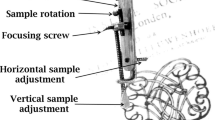Abstract
THE halo effect is well known in mass spectrometry and consists of a large black spot on the photographic plate in the neighbourhood of high intensity isotope lines. It causes an undesirable rise in the limit of detection of impurities with adjacent isotope masses. It was suggested1 in 1964 that this halation could be suppressed by applying a conductive layer between the emulsion and the glass of the photographic plate. The ions reflected by the silver bromide gelatin layer have lost a great deal of their energy, for example from 20 keV down to 2–4 keV. Some of these ions are brought back into the magnetic field which returns them to regions of the photographic emulsion corresponding to masses higher than those of the main isotopes.
Similar content being viewed by others
References
Addink, N. W. H., Limitations of Detection in Spectrochemical Analysis, 106 (Hilger and Watts Ltd., London, 1964).
Swift, P., Proc. Fifth Ann. A.E.I.-M.S.7 Users' Meeting, 12 (1965).
Mai, H., Adv. Mass Spectrom., 3, 163, edit. by Mead, W. L. (Elsevier, Amsterdam, 1966). Proc. Fifth Ann. A.E.I.-M.S.7 Users' Meeting, 60 (1965).
Mass Spectrometry, edit. by Reed, R. I., 225 (Academic Press, London and New York, 1965).
Author information
Authors and Affiliations
Rights and permissions
About this article
Cite this article
ADDINK, N. Suppression of Halo on Photographic Plates used in Mass Spectrometry. Nature 211, 1168–1169 (1966). https://doi.org/10.1038/2111168a0
Issue Date:
DOI: https://doi.org/10.1038/2111168a0
- Springer Nature Limited





